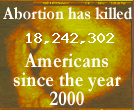Just when you thought we might secure the border...
Bush Administration Quietly Plans NAFTA Super HighwayGeeze... does anyone besides me feel just a tad bit uneasy with this thing... Ohhh... I don't know. Something about our national sovereignty comes to mind here; not to mention national security. The first checkpoint is supposedly going to be in Kansas City. There's a helluva lot of real estate between Laredo and Kansas City. And of course, with Minnesota being terrorism central as of the past six years, the fact that I-35 runs right through the heart of my home state doesn't work any charms on me either.
by Jerome R. Corsi
Posted Jun 12, 2006
Quietly but systematically, the Bush Administration is advancing the plan to build a huge NAFTA Super Highway, four football-fields-wide, through the heart of the U.S. along Interstate 35, from the Mexican border at Laredo, Tex., to the Canadian border north of Duluth, Minn.
Once complete, the new road will allow containers from the Far East to enter the United States through the Mexican port of Lazaro Cardenas, bypassing the Longshoreman's Union in the process. The Mexican trucks, without the involvement of the Teamsters Union, will drive on what will be the nation's most modern highway straight into the heart of America. The Mexican trucks will cross border in FAST lanes, checked only electronically by the new "SENTRI" system. The first customs stop will be a Mexican customs office in Kansas City, their new Smart Port complex, a facility being built for Mexico at a cost of $3 million to the U.S. taxpayers in Kansas City.
As incredible as this plan may seem to some readers, the first Trans-Texas Corridor segment of the NAFTA Super Highway is ready to begin construction next year. Various U.S. government agencies, dozens of state agencies, and scores of private NGOs (non-governmental organizations) have been working behind the scenes to create the NAFTA Super Highway, despite the lack of comment on the plan by President Bush. The American public is largely asleep to this key piece of the coming "North American Union" that government planners in the new trilateral region of United States, Canada and Mexico are about to drive into reality.
Just examine the following websites to get a feel for the magnitude of NAFTA Super Highway planning that has been going on without any new congressional legislation directly authorizing the construction of the planned international corridor through the center of the country.
- NASCO, the North America SuperCorridor Coalition Inc., is a "non-profit organization dedicated to developing the world's first international, integrated and secure, multi-modal transportation system along the International Mid-Continent Trade and Transportation Corridor to improve both the trade competitiveness and quality of life in North America." Where does that sentence say anything about the USA? Still, NASCO has received $2.5 million in earmarks from the U.S. Department of Transportation to plan the NAFTA Super Highway as a 10-lane limited-access road (five lanes in each direction) plus passenger and freight rail lines running alongside pipelines laid for oil and natural gas. One glance at the map of the NAFTA Super Highway on the front page of the NASCO website will make clear that the design is to connect Mexico, Canada, and the U.S. into one transportation system.
- Kansas City SmartPort Inc. is an "investor based organization supported by the public and private sector" to create the key hub on the NAFTA Super Highway. At the Kansas City SmartPort, the containers from the Far East can be transferred to trucks going east and west, dramatically reducing the ground transportation time dropping the containers off in Los Angeles or Long Beach involves for most of the country. A brochure on the SmartPort website describes the plan in glowing terms: "For those who live in Kansas City, the idea of receiving containers nonstop from the Far East by way of Mexico may sound unlikely, but later this month that seemingly far-fetched notion will become a reality."
- The U.S. government has housed within the Department of Commerce (DOC) an "SPP office" that is dedicated to organizing the many working groups laboring within the executive branches of the U.S., Mexico and Canada to create the regulatory reality for the Security and Prosperity Partnership. The SPP agreement was signed by Bush, President Vicente Fox, and then-Prime Minister Paul Martin in Waco, Tex., on March 23, 2005. According to the DOC website, a U.S.-Mexico Joint Working Committee on Transportation Planning has finalized a plan such that "(m)ethods for detecting bottlenecks on the U.S.-Mexico border will be developed and low cost/high impact projects identified in bottleneck studies will be constructed or implemented." The report notes that new SENTRI travel lanes on the Mexican border will be constructed this year. The border at Laredo should be reduced to an electronic speed bump for the Mexican trucks containing goods from the Far East to enter the U.S. on their way to the Kansas City SmartPort.
- The Texas Department of Transportation (TxDOT) is overseeing the Trans-Texas Corridor (TTC) as the first leg of the NAFTA Super Highway. A 4,000-page environmental impact statement has already been completed and public hearings are scheduled for five weeks, beginning next month, in July 2006. The billions involved will be provided by a foreign company, Cintra Concessions de Infraestructuras de Transporte, S.A. of Spain. As a consequence, the TTC will be privately operated, leased to the Cintra consortium to be operated as a toll-road.
If there's one issue I've disagreed heartily with Bush it's immigration. In the words of Ricky Ricardo, there's going to be one helluva lotta 'splainin' to do on Bush's part before I buy into this.
















|